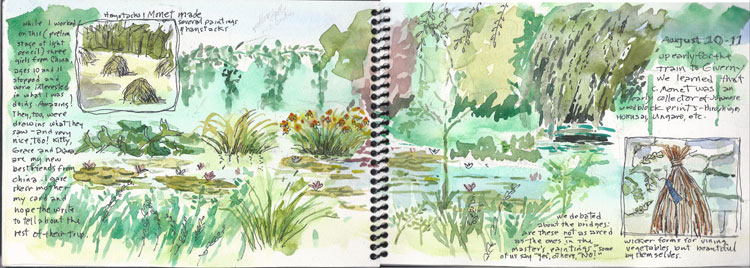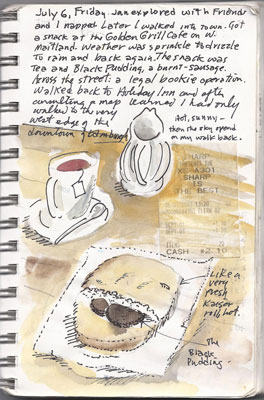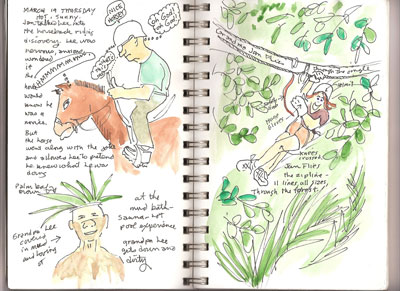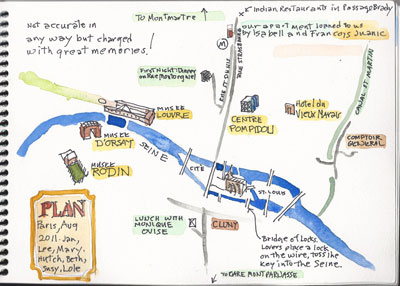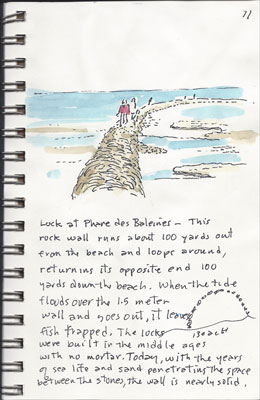Suggestions for sketching your next trip
by Lee Kline; Leesburg, FL
“Take a look at this photo. Was this the bridge over the Danube in Budapest or the bridge at Prague?”
“It sorta reminds me of one in Moscow.”
Has this ever happened to you? The journey is over and now you’re home sorting through all the photos you snapped along the way. You look through that heap of shots on your computer’s desktop or the stack of 500 prints you ordered at Walgreens that you promised yourself you would organize, but memory has faded and the back-and-forth dialog between you and your travel companion begins.
Many experienced travelers carry journals and record dates, times and places, inserting, perhaps, even short notes on personal impressions of the experience. There may be a running column in the back of the journal where every bit spent on meals, transportation, souvenirs, tips and so forth is listed in chronological order. Next time, why not expand your record to include some sketches and drawings and turn it into a sketchbook/journal?
Creating memories
When you stop to sketch something that catches your eye on a journey, it will stay with you. That is a promise, and it doesn’t matter how quick, crude or rough the sketch.
I can look at sketches made on our travels 35 years ago and tell you the time of day, the weather and the personal encounters I had while making that sketch. The reason I can remember the specifics about the occasion of a drawing is simple: I stopped and paid attention to my surroundings.
Perhaps I spent one minute, five minutes or even 30 making my sketch. The point is that I stopped and looked — really looked — because something caught my eye.
My wife, Jan, and I snap many photos, and we often have the same dialog about them as the couple at the top of this article. The reason for our bewilderment as to the subject, time, location and occasion of a photograph is that we simply snapped away and moved along to the next thing.
Nobody watched silently over our shoulders as we shot our photos. Nobody asked to see the photo we were shooting. Nobody smiled and said, “Looks just like it!” or mentioned that it was the house they grew up in. But when I’ve stopped to sketch, I’ve had the most wonderful encounters.
Local interaction
In cultures that appreciate and respect artists, there are always people who will want to talk with you about what you are drawing. They are proud of the fact that you stopped to take the time to look at how and where they live. They appreciate that you found something in their life interesting or beautiful.
I was drawing in Lebanon over 35 years ago when a young boy came up and talked to me, practicing his English. (I get that a lot.) Then he asked if he could borrow one of my pencils. I handed it over, thinking he would next ask for a sheet of paper. Instead, he was off like a shot.
I thought, ‘Good-bye, pencil.’ It was my first trip overseas, and I figured that even if I lost the pencil, the encounter had been friendly and memorable.
I drew for perhaps a half hour, but the sun was blazing and I needed something cool to drink. As I was putting my things away, the boy returned with a drawing he had done. He presented it to me, handing over the pencil as well. I still have the sketch he made, and I hope he made a hundred drawings with that pencil and the two others I gave him from my kit.
This type of experience has repeated itself every year since, wherever and whenever we have traveled. In the summer of 2011 we returned to France, where our daughter has lived for 20 years. We decided to go to Giverny, Monet’s home north of Paris.
Many travelers know about Giverny and its gardens. Of course, I had to draw and paint my impressions in my sketchbook/journal. While my 10-year-old granddaughter was off snapping photos of the wondrous flowers, I began a sketch.
I was approached by three 10-year-old Chinese girls who also carried sketchbooks. They wanted to practice their English and I wanted to see their sketches, so we showed each other our work. I was old enough to be their grandpapa, but it didn’t matter to them; we were artists sharing a moment in a wondrous place. We exchanged names and addresses.
Getting started
I hear some of you saying, ‘But I can’t draw.’ Before your next journey, consider going to the local library and checking out a couple of books on sketching. Mine has many and our local community college has many more.
Try some practice sketches on plain paper from your computer’s printer, and don’t worry about the quality of what you draw. Read what those books have to say about seeing.
Buy a sketchbook. Until I began making my own, I favored Strathmore’s 400 Series Sketch (5½"x 8½"), with 100 pages of 60-pound paper.
At a dollar store, grab two or three glue sticks. I find that if I want heavier pages for watercolor, I can glue two pages back to back.
I also take along fine-point Sharpie pens plus pencils ranging from 3B to 8B.
If you want to play with color, look for a small watercolor set, even a child’s set (also at the dollar store), but spend a little on a good No. 6 sable brush.
All of these items are available online.
So, how to begin? My suggestion is that you leave the first page of your sketchbook blank. You may decide later to make it a “cover” page or an introduction page. I often save it for a drawing of a map of the places we’ve been on that trip.
When you get to your destination and finally screw up the courage to draw, pick a safe place such as a café where you can sit mostly unobserved, making sure you are not sitting where a bus might pull up to hide the beautiful view.
Then, before you put a mark on the page, draw a small two-by-two-inch box or circle in one corner of the page for what I call serendipity. I do this knowing, after a few years’ experience, that the scene I plan to draw is going to offer up a little visual reward of something I had not included in my original composition.
A sign with a funny spelling might be spotted after my sketch is finished, for example, or a couple of crazy pigeons might pester me for crumbs. Perhaps after I’m finished drawing and am rewarding myself with an espresso, I’ll draw that in my box to add to my memories.
You might want to begin at the departure lounge of the airport, before your real journey begins. Sketch people waiting for their flights. Most will be reading or snoozing and won’t see you at work.
It is a bit scary putting those first tentative marks into your new sketchbook, but be brave! Tell yourself that you may never get this chance again.
Include your written observations, incorporate your receipts and don’t forget to grab all the brochures you can lay your hands on. I rip ’em up and paste some of their photos on pages to emphasize or illustrate something I want to remember.
Finding inspiration
Are you an obsessive list maker? Once, while on a walk along the entire route of Hadrian’s Wall, I listed all of the plants there that I recognized as being in the United States. In Costa Rica, I kept a running tally of birds, primates, mammals and reptiles as we progressed through that beautiful country. So don’t overlook listing things that interest you.
Begin today. Plan for that next trip. You might think of a theme that you wish to follow on your journey. Remember those posters of the doors of Dublin? Something like 36 different doors are portrayed. Who says you can’t sketch your morning coffee cup? A two-week trip will net 14 different cups and probably a story to go with each as your fellow travelers watch with curiosity, at first, then with interest and, finally, with envy.
If you wish to see more complete sketchbooks of some of our travels, visit our Flickr page.

